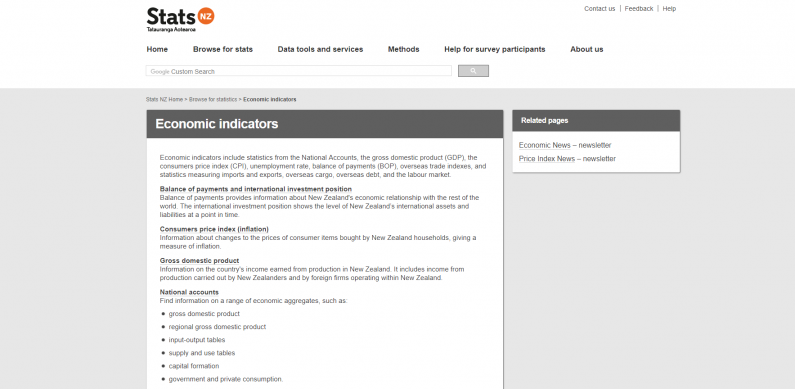Economic indicators

Purpose of agency
Stats NZ is New Zealand’s national statistical office and leader of the Official Statistics System. It is New Zealand's major producer of official statistics, delivering and disseminating the most important statistics that require the highest levels of credibility and integrity. Stats NZ is governed by and administers the Statistics Act 1975.
What high-value public data has been released for re-use?
Economic indicators data is regularly released by Statistics NZ. Most of these indicators are updated on a quarterly and annual basis. The releases include:
- gross domestic product (GDP), New Zealand’s measure of economic growth
- consumers price index (CPI), used to calculate the inflation rate
- balance of payments (BOP), which shows New Zealand's financial transactions with the rest of the world
- productivity statistics, which measure how efficiently production inputs are being used within the economy to produce output.
The public can browse, access, and download the data on Stats NZ’s website. They can also subscribe to specific economic indicator releases or use the online tools to find more detailed information. The data is available in MS Excel (.xls), comma delimited (.csv), table query (.tqx) and Beyond 20/20 table format (.ivt).
Release rationale
Businesses can use economic indicator data to add value, innovate, and create new products to spur economic growth. The government, community organisations and the general public can also use economic indicators data in a number of valuable ways. In order to serve a wide range of users, the statistical information is delivered in a broad range of formats, including information in reports and products, through to the release of aggregated data, and restricted release of microdata via the microdata access services.
Risk mitigation
Confidentiality and privacy - The confidentiality and privacy of individuals is protected at all times. The Statistics Act governs the way that Statistics NZ manages confidential information. This information can only be used for statistical purposes, must be kept secure to prevent unauthorised access, and must not be released where it could lead to disclosure of individuals' details. Where necessary, Stats NZ adjusts data to make sure that no individual or business can be identified using techniques such as random rounding, collapsing categories, and suppressing cells.
Data integrity - Stats NZ uses administrative data as the primary source of business information, with statistical surveys used to fill the gaps that cannot be met from administrative sources. Robust processes are in place to manage both the supply and use of administrative data to ensure this does not compromise the quality of statistical outputs.
Cost and timeframe
Release of data for re-use is part of Statistics NZ’s core business and does not incur additional cost.
Economic and social impacts
- Financial institutions and private research agencies (eg. BERL, NZIER) use it for research, forecasting, and public and social policy analysis.
- ANZ Bank uses GDP data and traffic flow data from the NZ Transport Authority to construct the ‘Truckometer’, a monthly economic indicator.
- Schools, universities, and post-graduate students use it when carrying out research on the economy.
- News media use it to inform the general public and to verify and add to stories about the New Zealand economy.
- The Reserve Bank uses it for their Financial stability report and the official cash rate announcements
- Treasury uses it to prepare the Budget, the Monthly economic indicators publication and economic impact reports.
Transparency and democratic impacts
- Using GDP data, Treasury publishes information about crown entities and State Owned Enterprises, setting out total Crown debt, operating balance, expenses, and revenues as a percentage of GDP
- The 100 companies mash-up used economic indicators data to inform the public about the factors that affect prosperity.
- Ministry of Foreign Affairs and Trade and New Zealand Customs Service use it for international trade negotiations and border control.
- Ministry of Economic Development uses it to understand the economic impacts of tourism and provide a wide range of information on domestic and international tourism.
- Productivity Commission uses Statistics NZ productivity data to increase awareness of productivity and to find ways to grow productivity to improve the well-being of New Zealanders.
- Organisation for Economic Cooperation and Development uses trade and investment data on New Zealand, which originates from Stats NZ’s trade and investment figures.
- Interest groups like the NZ Institute, Council of Trade Unions, and Business NZ, along with non-government organisations, use the data to support their respective group’s policies and initiatives.
Efficiency impacts
- New Zealand Superannuation entitlement computation is linked to the CPI and average weekly earnings
- Information on inflation and wage rates is used by individuals, unions, private businesses, and government to inform negotiations of remuneration-related contracts.
- Ministry of Business, Innovation and Employment, together with the Treasury and Statistics NZ, produce the Economic development indicators report, which tracks New Zealand’s medium-term economic performance over time and compared with other OECD countries.
- Local Government NZ, through BERL, published the Local Government Economic Indicators Framework that identifies the contribution of local government to economic growth in New Zealand as a whole.
Find out more
